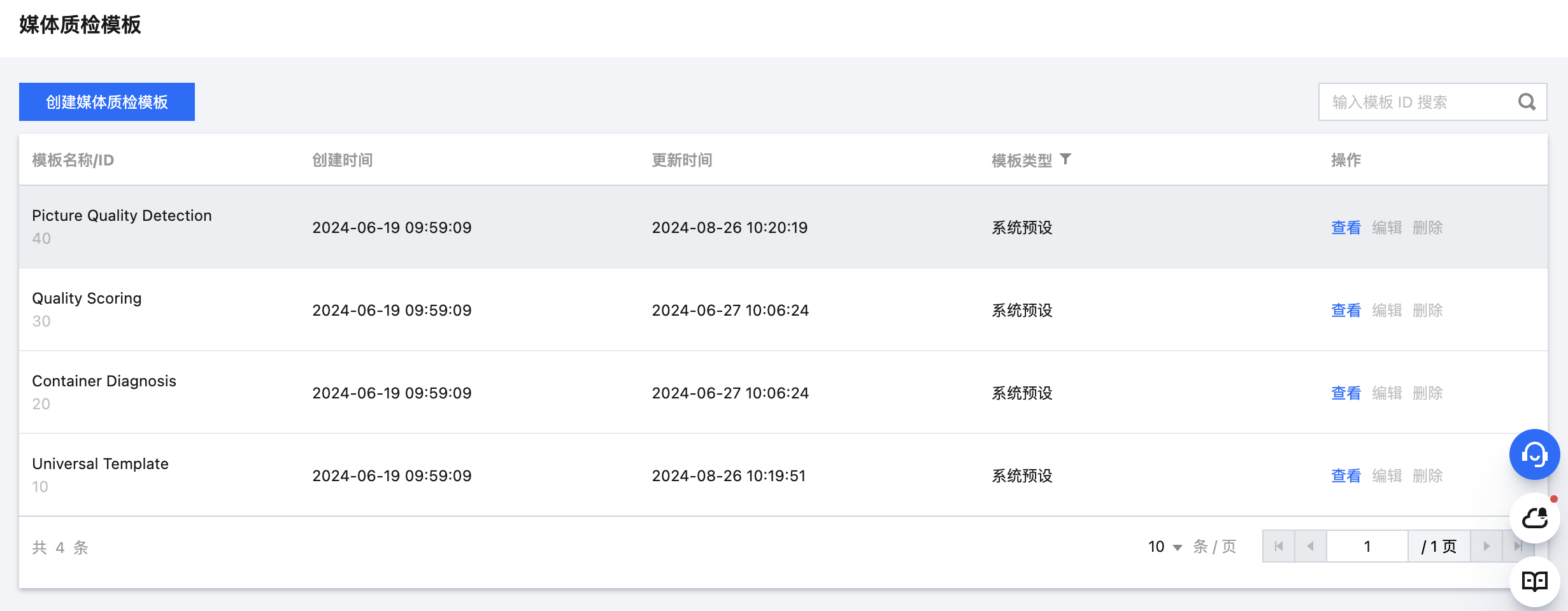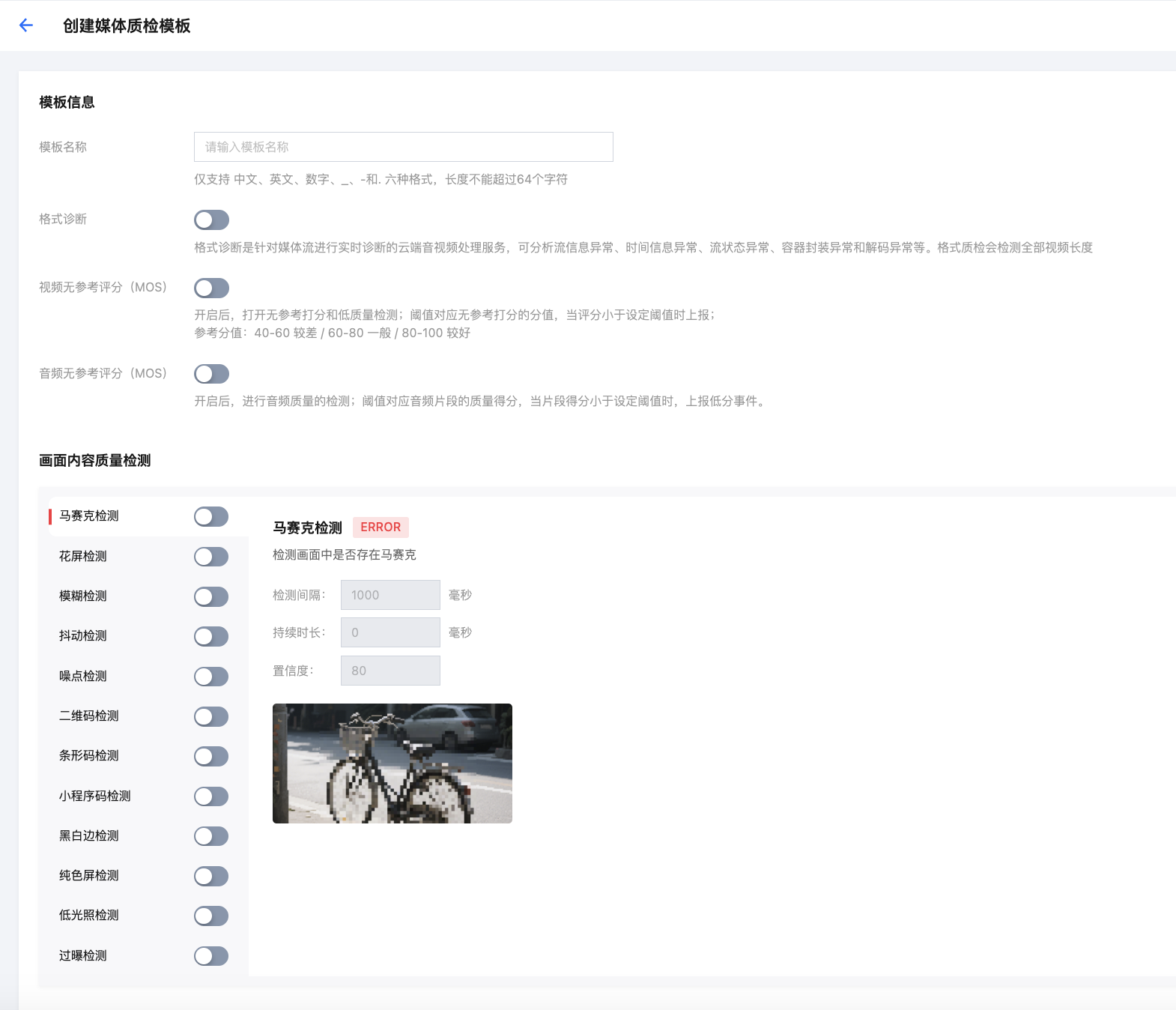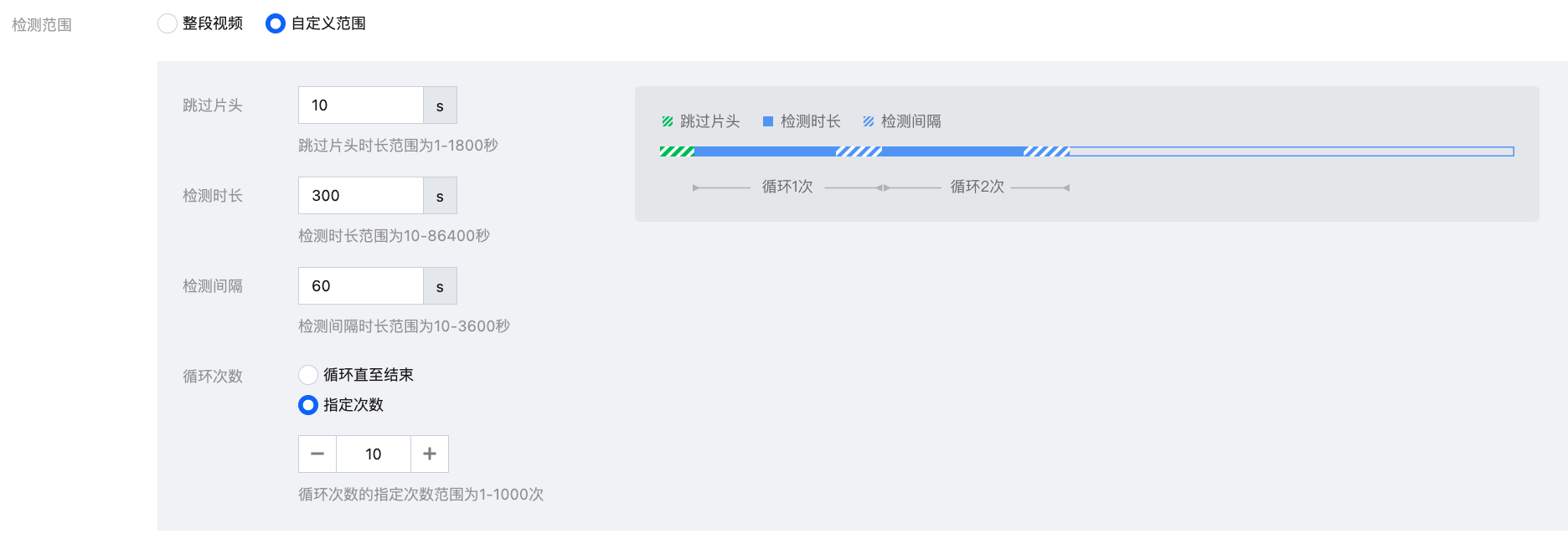媒体质检模板
最后更新时间:2025-09-26 11:02:48
概述
媒体质检服务可以全面识别媒体资产问题,验证内容是否符合要求,并提供相应的建议。用户可以在控制台直接使用预设模板或创建媒体质检模板,来自定义质检参数。


质检内容包括:
格式诊断:媒体诊断是针对媒体流进行实时诊断的云端音视频处理服务,可分析流信息异常、时间信息异常、流状态异常、容器封装异常和解码异常等。
无参考评分:对视频质量进行无参考状态下的打分,分数区间在0-100分。
画面质量:提供包括但不限于花屏、黑屏、抖动、噪点、马赛克、低光照、二维码、条形码、小程序码检测等多种质检功能。
声音检测:提供包括但不限于静音、低音、爆音检测等多种质检功能。
质检模板参数说明

检测类型 | 检测项 | 参数说明 |
格式诊断 | 格式诊断 | 媒体诊断是针对媒体流进行实时诊断的云端音视频处理服务,可分析流信息异常、时间信息异常、流状态异常、容器封装异常和解码异常等。 |
质量评分 | 视频无参考评分(MOS) | 开启后,打开无参考打分和低质量检测。 参考分值: 40-60分:质量较差; 60-80分:质量一般; 80-100分:质量较好。 可设置“阈值”和“检测间隔”两个参数。阈值对应无参考打分的分值,当评分小于设定阈值时上报;检测间隔单位是毫秒(ms)。 |
| 音频无参考评分(MOS) | 开启后,进行音频质量的检测;阈值对应音频片段的质量得分,当片段得分小于设定阈值时,上报低分事件。 |
画面质量问题 | 马赛克检测 | 检测画面中是否存在马赛克。当检测出的置信度大于等于设定值时上报。 置信度取值范围 [0,100]; 检测间隔单位是毫秒(ms),取值需大于500ms; 持续时间范围 0-600000ms。 |
| 花屏检测 | 检测由于传输错误或解码错误等问题造成的画面损坏、错乱、扭曲等效果。当检测出的置信度大于等于设定值时上报。 置信度取值范围 [0,100]; 检测间隔单位是毫秒(ms),取值需大于500ms; 持续时间范围 0-600000ms。 |
| 模糊检测 | 检测由于聚焦不当或物体运动等原因导致的图像模糊。阈值为检测时的评估基准,阈值设置得越大,图片越容易被认为是模糊。 阈值取值范围 [0,100]; 检测间隔单位是毫秒(ms),取值需大于500ms; 持续时间范围 0-600000ms。 |
| 抖动检测 | 检测由于录制设备晃动导致的画面抖动。阈值为判定抖动的基准,阈值越大抖动越剧烈,抖动剧烈程度大于设置阈值时上报。 阈值取值范围 [1,10]; 检测间隔不可设置; 持续时间范围 0-600000ms。 |
| 噪点检测 | 检测画面是否存在随机分布的黑白斑点、噪点等类似雪花效果的现象。阈值为判定噪点的基准,阈值越大噪点越明显,噪点强度大于等于设置阈值时上报。 阈值取值范围 [0,100]; 检测间隔单位是毫秒(ms),取值需大于500ms; 持续时间范围 0-600000ms。 |
| 二维码检测 | 检测画面中是否存在二维码。当检测出的置信度大于等于设定值时上报。 置信度取值范围 [0,100]; 检测间隔单位是毫秒(ms),取值需大于500ms; 持续时间范围 0-600000ms。 |
| 条形码检测 | 检测画面中是否存在条形码。当检测出的置信度大于等于设定值时上报。 置信度取值范围 [0,100]; 检测间隔单位是毫秒(ms),取值需大于500ms; 持续时间范围 0-600000ms。 |
| 小程序码检测 | 检测画面中是否存在小程序码。当检测出的置信度大于等于设定值时上报。 置信度取值范围 [0,100]; 检测间隔单位是毫秒(ms),取值需大于500ms; 持续时间范围 0-600000ms。 |
纯色屏检测 | 黑白边检测 | 检测画面的四周是否存在黑白边。 阈值取值范围 [0,50]; 检测间隔单位是毫秒(ms),取值需大于500ms; 持续时间范围 0-600000ms。 |
| 纯色屏检测 | 检测画面是否只有一个颜色。阈值为低光照像素的百分比,当检测百分比大于等于设置阈值时上报。 阈值取值范围 [90,100]; 检测间隔单位是毫秒(ms),取值需大于500ms; 持续时间范围 0-600000ms。 |
亮度检测 | 低光照检测 | 检测画面亮度是否过低。阈值为低光照像素的百分比,当检测百分比大于等于设置阈值时上报。 阈值取值范围 [80,100]; 检测间隔单位是毫秒(ms),取值需大于500ms; 持续时间范围 0-600000ms。 |
| 过曝检测 | 检测画面亮度是否过高。阈值为过曝像素的百分比,当检测百分比大于等于设置阈值时上报。 阈值取值范围 [50,100]; 检测间隔单位是毫秒(ms),取值需大于500ms; 持续时间范围 0-600000ms。 |
声音检测 | 静音检测 | 检测音频是否存在静音的情况。 阈值取值范围不可编辑; 检测间隔单位是毫秒(ms),取值需大于0ms; 持续时间范围 0-600000ms。 |
| 低音检测 | 检测音频是否存在音量低片段。当音频分贝低于设定值时上报。 响度取值范围 [0,20]; 检测间隔单位是毫秒(ms),取值需大于0ms; 持续时间范围 0-600000ms。 |
| 爆音检测 | 检测音频是否存在音量过高片段。当音频分贝高于设定值时上报。 响度取值范围 [70,96]; 检测间隔单位是毫秒(ms),取值需大于0ms; 持续时间范围 0-600000ms。 |
检测设置
检测设置提供对检测范围的自定义控制,以及对检测问题的记录方式。

质检问题记录方式
默认会记录质检问题出现的时间段,如选择“问题段首尾截图”,在质检报告结果查看时,还可以查看出现质检问题的首尾2张截图。
注意:
开启“问题段首尾截图”,除质检费用外,还会产生截图费用,和图片存储费用。
检测范围
质检默认会检测全部视频范围,同时也支持设置自定义检测范围,开启自定义范围后如下图

跳过片头:在每个质检任务发起时,会先跳过指定的时长后,再开启检测,该功能适用于视频内容包含固定的片头的场景,可以避免检测重复的视频内容。跳过片头时长范围为1-1800秒。
检测时长:检测时长指定了每一次质检动作的持续时长,是对视频进行抽样质检的关键参数。针对大量视频内容,设置检测时长可以帮助显著节省质检成本。例如,设置检测时长为300秒,质检任务会在执行时只检测300秒的视频,而无需对全部的视频长度进行质检。(检测时长参数的填写范围为10-86400秒)
检测间隔:设置检测间隔和检测时长后,质检可以实现例如在每小时的视频中,抽取5分钟进行检测的效果。(检测间隔时长范围为10-3600秒)
循环次数:用于限制循环抽检的次数。默认情况下,循环抽检会持续执行“检测-间隔等待-检测”操作,直至视频内容全部检测完毕。设置循环次数后,质检将在达到指定循环次数后停止检测。

文档反馈

